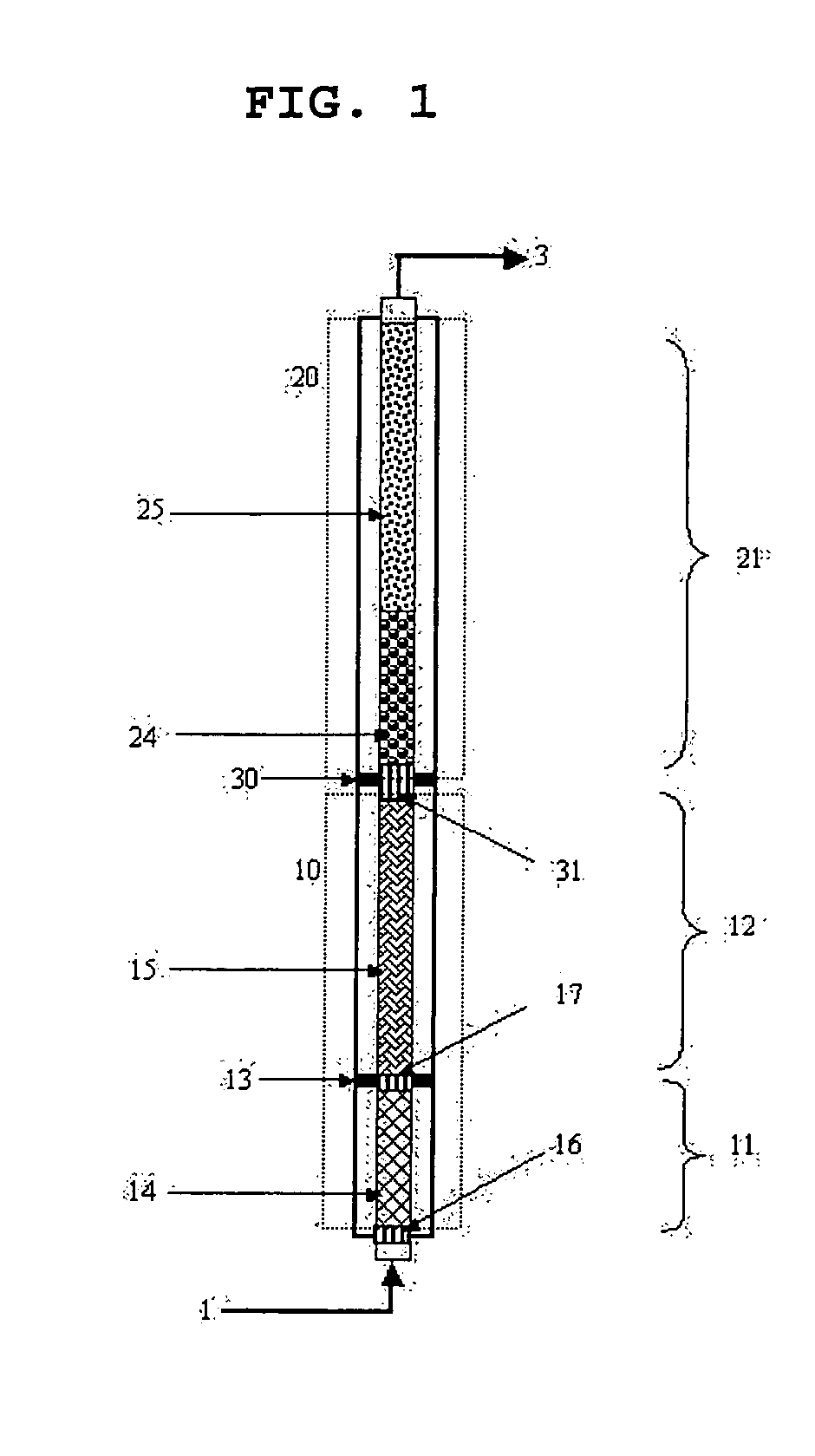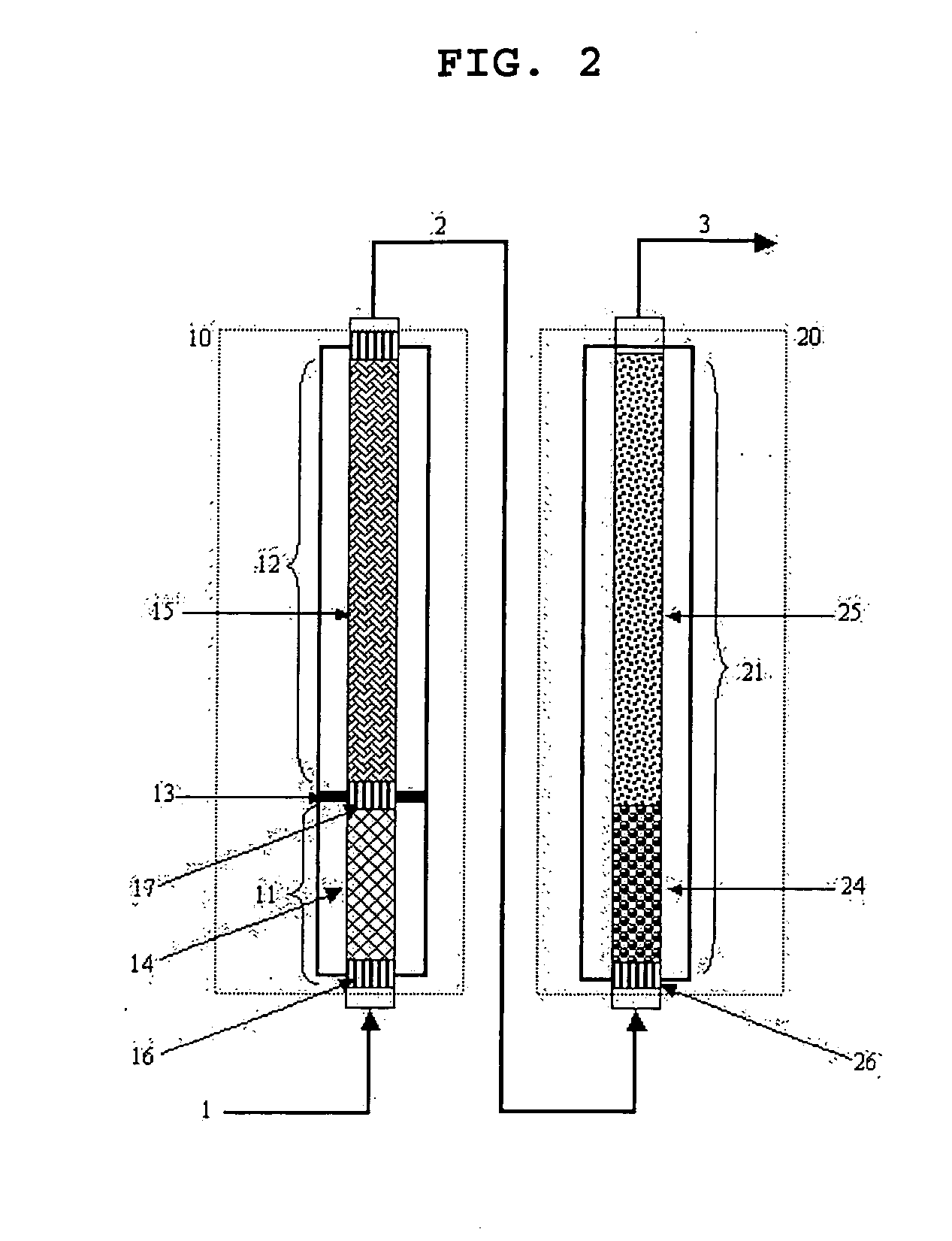Method of producing unsaturated aldehyde and unsaturated acid in fixed-bed catalytic partial oxidation reactor with enhanced heat control system
- Summary
- Abstract
- Description
- Claims
- Application Information
AI Technical Summary
Benefits of technology
Problems solved by technology
Method used
Image
Examples
example 1
(Improved Heat Control System): Changes in Yield and the Magnitudes of Temperature Peaks at Hot Spots with Change in Setting Temperature of Molten Salt
[0090] As shown in FIG. 3, a pilot reactor was provided in which each of first-step reaction and second-step reactions is conducted in one catalytic tube (included in the zone 10 or 20 of FIG. 3). Each of the catalytic tubes is 26 mm in inner diameter, and the first-step catalytic tube was filled with catalytic layers with a height of about 1200 mm, and the second-step catalytic tube was filled with catalytic layers with a height of about 1100 mm. Reference numerals 11 and 12 in FIG. 3 denote the divided shell spaces of the first-step reaction zone. The temperatures of molten salts filled in the shell spaces are 300° C. and 305° C., respectively. Reference numeral 21 in FIG. 3 is a shell space into which a molten salt is filled and set to 265° C. The two catalyst layers filled in the first-step reaction zone 10 are made of a catalyst...
example 2
(Improved Heat Control System): Changes in Yield and the Magnitudes of Temperature Peaks at Hot Spots with Change in Setting Temperature of Molten Salt
[0095] This example was performed in the same manner as in Example 1 except for the setting temperatures of a molten salt in the first-step reaction zone (first-step reactor). The temperatures of the molten salt in the first-step reaction zone were set to 300° C. and 310° C., respectively, in an axial direction.
[0096] In the zone corresponding to the first shell space in the first-step reaction zone, a hot spot with a temperature of 381.5° C. was formed. The yields of acrolein and acrylic acid were 81.13% and 9.30%, respectively. In the second-step reaction zone which is operated at isothermal conditions, the temperature of a hot spot was 320.0° C., and the yields of acrolein and acrylic acid were 1.18% and 84.35%, respectively.
example 3
(Improved Heat Control System): Changes in Yield and the Magnitudes of Temperature Peaks at Hot Spots with Change in Setting Temperature of Molten Salt
[0097] This example was performed in the same manner as in Example 1 except for the setting temperatures of a molten salt in the first-step reaction zone (first-step reactor). The temperatures of the molten salt in the first-step reaction zone were set to 300° C. and 315° C., respectively, in an axial direction.
[0098] In the zone corresponding to the first shell space in the first-step reaction zone, a hot spot with a temperature of 381.2° C. was formed. The yields of acrolein and acrylic acid were 79.02% and 11.46%, respectively. In the second-step reaction zone which is operated at isothermal conditions, the temperature of a hot spot was 327.5° C., and the yields of acrolein and acrylic acid were 0.607% and 84.95%, respectively.
PUM
| Property | Measurement | Unit |
|---|---|---|
| Temperature | aaaaa | aaaaa |
| Temperature | aaaaa | aaaaa |
| Fraction | aaaaa | aaaaa |
Abstract
Description
Claims
Application Information
 Login to View More
Login to View More - R&D
- Intellectual Property
- Life Sciences
- Materials
- Tech Scout
- Unparalleled Data Quality
- Higher Quality Content
- 60% Fewer Hallucinations
Browse by: Latest US Patents, China's latest patents, Technical Efficacy Thesaurus, Application Domain, Technology Topic, Popular Technical Reports.
© 2025 PatSnap. All rights reserved.Legal|Privacy policy|Modern Slavery Act Transparency Statement|Sitemap|About US| Contact US: help@patsnap.com



